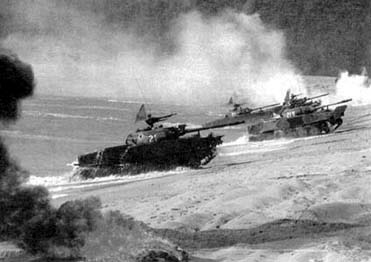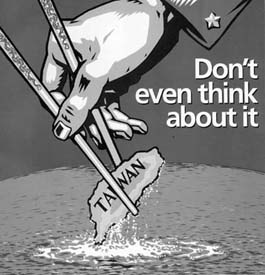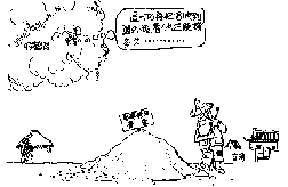 Taiwan Communiqué
No. 70, March 1996
Taiwan Communiqué
No. 70, March 1996 Taiwan Communiqué
No. 70, March 1996
Taiwan Communiqué
No. 70, March 1996In our previous issue (Taiwan Communiqué no. 69, January 1996), we reported on the Chinese threats against Taiwan, and outlined why the Taiwanese do not have any desire whatsoever to "unify" with China.
Since then, the Communist Chinese campaign to intimidate and bully Taiwan and the military threats have intensified significantly. As this issue of Taiwan Communiqué was going to press, the Chinese had just announced that they would conduct new missile tests just 12 miles off the coast of Taiwan, and had launched the first three missiles. Below, an overview of the events, and a survey of the international response.
The first piece of evidence of the increasing belligerent behavior of the Chinese came in an article in the New York Times of 24 January 1996, which reported that the PRC's People's Liberation Army had completed plans for a conventional missile strike against Taiwan each day for 30 days, if Taiwan presses on with its quest for international status. The report stated that this information was contained in a message carried earlier in January 1996 from Beijing by former Assistant Secretary of Defense Chas. W. Freeman Jr. The report stated also that the attack would be mounted in the weeks after Taiwan's presidential elections of 23 March 1996.

In the subsequent days, Chinese Prime Minister Li Peng (the "Butcher of Tienanmen") made further statements threatening and bullying Taiwan: on January 30th, he said in a speech commemorating that one year ago Chinese President Jiang Zemin launched his stillborn "Eight-Point Plan" (see Taiwan Communiqué no. 65, April 1995), that China would not give up the use of force.
On 5 February 1996, the Washington Post reported ("China Plans Maneuvers off Taiwan") that US intelligence reports indicated that the Chinese were pulling together a military force of some 150,000, had more than doubled the number of fighter planes along the coastline, and was deploying amphibious landing craft in Xiamen and Pingtan, near the Taiwan-held islands of Kinmen and Matsu. In the subsequent weeks the threat of a military action increased, as the Chinese moves grew bolder ("China Masses Troops on Coast Near Taiwan", Washington Post 14 February 1996).
However, in spite of American warnings (see article "What is the Western response?" below) , and many international expressions of concern, the Chinese started to launch ballistic Scud-type missiles at two areas just off the coast of Taiwan, one 30 miles to the southwest of the island, and the other only 12 miles to the northeast of Taiwan.
What are the real reasons for China's belligerence. Analysts have come up with three factors, and feel that a combination of these are prompting the irresponsible behavior of the Chinese Communist leaders:
In response to the military threat from China, the Taiwanese community in the United States and Canada on 8 March 1996 issued the following appeal:
President William J. Clinton Washington March 8th, 1996
The White House
Dear President Clinton:
As representatives of the Taiwanese American community, we write you to register our strongest protest against China's latest round of live missile exercises, scheduled to take place between March 8 and 15, and targeted as close as 12 miles from Taiwan's largest trading ports of Keelung and Kaohsiung. The proximity of these exercises to Taiwan will create a virtual blockade of these vital trade ports. We must make it clear to Beijing that this escalation of its military threats against Taiwan and this blockade are totally unacceptable. Moreover, these exercises are scheduled to take place just before Taiwan's first-ever democratic presidential election on March 23, and are clearly designed to intimidate Taiwan's voters and disrupt Taiwan's trade and economy. We urge the United States to condemn this latest Chinese attempt at intimidation and obstruction of Taiwanese democracy.
China's announcement of missile exercises, coming after strong statements from Secretary Perry and Assistant Secretary Lord, indicate that American words are not enough and that the Chinese do not take the United States seriously. It is time to consider specific concrete actions. We urge the Administration to begin by taking the following three steps. First, publicly condemn China's continued threats and military provocations, which violate the provision for peaceful settlement with Taiwan, as mandated by the Taiwan Relations Act. Second, send a message to Beijing by speeding up the delivery of weapons systems already contracted for and purchased by Taiwan, such as the F-16, Patriot, and anti-missile defense system. Third, consider other deficiencies in Taiwan's security and enhance Taiwan's capabilities to defend itself.
Regardless of China's military capabilities or strategies, this latest Chinese attempt poses a serious threat to the Taiwanese people. In the last round of Chinese missile exercises, one live round missed its target by over 200 nautical miles. Furthermore, as the world's 13th largest trading nation and the 7th largest trading partner of the United States, what may amount to an eight-day blockade of Taiwan's main trading ports must not be taken lightly. Finally, the firing of live ammunition into international waters constitutes a blatant violation of international law and presents great hazards to some of the world's most important shipping and air lanes.
Mr. President, the time has come for the United States to take a strong stand against China's hegemonistic acts. China's transfer of nuclear and conventional weapons and technology to non-democratic states, violation of an international moratorium on nuclear weapons testing, and continued violations of intellectual property rights laws are proof positive that the current United States policies of "quiet diplomacy" or "strategic ambiguity" have failed. As representatives of the Taiwanese American community, we strongly urge you to take the actions outlined above, and begin by immediately issuing a strong, public condemnation of these exercises and reiterating the United States' commitment to peace in the Taiwan Straits.
The Statement was endorsed by more than twenty Taiwanese organizations in the United States and Canada.
On 25 January 1996, the New York Times commented in an editorial ("China Threatens Taiwan"): "(The Chinese threats) ... suggest that Beijing has lost sight of one of the basic understandings underlying the improved Chinese-American relations since the Nixon Administration that Taiwan's future must be settled by peaceable means."
.... Taiwanese point to their centuries of separate cultural development and, more importantly, their hard-won political democracy and thriving capitalistic economy as good reasons for standing somewhat apart. ..... More than anything else, it is the fear that todays freedoms and prosperity would be lost under Beijing harsh authoritarian rule that fuels Taiwan's quest for a separate identity. .... The United States must vigorously reject military bullying from Beijing in cases like this.
A few days later, on 2 February 1996, columnist A.M. Rosenthal described in an excellent piece on the editorial page of the New York Times how US Secretary of State Dean Acheson in a speech in January 1950 did not include South Korea within the defense perimeter to be protected by the United States. Six months later North Korea attacked the South. Drawing a parallel with today, Mr. Rosenthal urged a much firmer posture of the US, and said that the US should clearly spell out to China the consequences of its actions.
In what was one of the best reactions during this period, the London-based The Economist highlighted the Chinese threats against Taiwan on the cover of its February 3 - 9 1996 issue, and clearly stated: "Don't even think about it." The Economist concluded its excellent editorial with the following words: "And if China blunders on? The job of America and its allies is to help Taiwan defend itself. That means providing it with anti-missile defenses and other military equipment and, if necessary, moving ships from the American Seventh Fleet into position between China and Taiwan."

"Too provocative ? It is China that is being provocative. By leaving China with the impression that it can swallow Taiwan at will, America would be nourishing this crisis. Only clarity now and toughness, where needed, can bring it to an end."
On 6 February 1996, the Washington Post stated in an editorial ("If China Attacks Taiwan"): "If it came to that, the United States would have no choice but to help Taiwan a flourishing free-market democracy defend itself against attack by Communist China. No treaty or law compels this response, but decency and strategic interest demand it. An American government that allowed the issue of Taiwan's future to be settled by China's force would be in disgrace as well as in error."
In another excellent article on the issue, Columnist Jim Hoagland wrote in the Washington Post on 11 February 1996 ("China, before there is a War"): "The Clinton Administration now confronts the consequences of clinging to a failed China policy ..... The US concessions that have been justified in the name of engagement .... have not purchased moderation."
The increasing unpredictability of China and its push for expanding its capability to militarily threaten others came in the beginning of February 1996, when almost simultaneous reports were published in the New York Times and Washington Post that China was purchasing 72 high-performance Sukhoi-27 fighter planes from Russia, and had exported sensitive nuclear weapons-related equipment to Pakistan.
On 7 February 1996, the New York Times reported that the Sukhoi-27 deal was announced in Moscow by the commander of the Russian Air Force, general Pyotr Dneikin ("China to Buy 72 Advanced Fighter Planes from Russia", NYT, 7 February 1996). The $ 2 billion deal involves a license to produce the SU-27 in China.

During the same period there were reports that China was negotiating with a Spanish shipyard for the purchase of an aircraft carrier which could carry S- and VTOL military aircraft ("Boost in Chinese Buildup fuels Asian worry", Defense News, January 29 - February 4, 1996).
On 8 February 1996, the Washington Post reported that China had sold 5,000 specialized magnet rings which are used in the production of highly enriched uranium. The report stated that, incredibly, the United States was considering to waive economic sanctions against China ("US May Waive Sanctions for sale Related to Nuclear Arms", 8 February 1996). Such sanctions are mandatory under a series of US laws meant to deter and punish nuclear proliferation.
In an editorial on the following day, the Washington Post expressed its exasperation at the fact that the Clinton Administration was even thinking about the possibility of a waiver, stating that the Administration's China policy is "...at the edge of incoherence" ("China's Nuclear Exports", Washington Post, 9 February 1996).
Finally, at the end of February 1996, it was announced that the United States had asked the Export-Import Bank to defer any new financing for American companies doing business with China for one months, while the Administration was weighing how to respond to the evidence that China had shipped nuclear technology to Pakistan in violation on international non-proliferation treaties and US laws.
By many this was still considered only a half-hearted step. The New York Times stated in an editorial on 26 February 1996 that the United States should try stronger forms of pressure, including "...signing up American allies to apply coordinated penalties when international treaties are seriously breached." The Times continued: "...Washington must be prepared to apply the full rigor of American law in cases like the magnet sales to Pakistan" ("Better Tools Needed on China", NYT, 26 February 1996).
Finally, in the beginning of March 1996, the American publication Defense News reported that China was accelerating its development of a ground-launched, land attack version of the C-802 antiship missile. The low-flying cruise-type missile was still needing development of guidance packages based on the U.S. Global Positioning System (GPS) and terrain contour-matching radar systems.
According to the Defense News report the Chinese goal is to develop a cruise missile that could hit the presidential palace in Taipei "with minimal collateral damage." The report also said that China was developing several new ballistic missile systems, including the DF-31, a new mobile missile with a planned range of about 8,000 kilometers, and the DF-41, a new intercontinental missile designed to carry multiple warheads ("China speeds development of missile with Taiwan range", Defense News, March 4-10, 1996).
Back to: Table of Contents
Copyright © 1996 Taiwan Communiqué